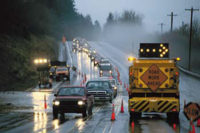Workers who must perform tasks in close proximity to traffic and using heavy machinery face obvious dangers, such as speeding, distracted or impaired drivers and loud traffic noise that may mask the approach of work vehicles.
To better understand the injury risks to which highway work zone employees are exposed, the National Institute for Occupational Safety and Health (NIOSH) reviewed the current literature on highway safety, analyzed data on worker fatalities in the highway and street construction industry, and held a workshop with individuals from government, labor, industry, academia, and state departments of transportation. During the workshop, participants were asked to discuss measures that could be taken by employers, manufacturers, and government and research agencies that would reduce or eliminate these hazards.
The document that arose from that process, Building Safer Highway Work Zones: Measures to Prevent Worker Injuries From Vehicles and Equipment, draws on the collective knowledge, experience, and expertise of numerous individuals and organizations who are intimately involved with highway construction. By bringing together partners from all parts of the industry to discuss prevention of these injuries, NIOSH hopes to improve the understanding of the hazards faced by highway workers, raise the industry's awareness of these hazards, and initiate discussion among all concerned about measures that can reduce these hazards.
The material presented in this document does not constitute an all-inclusive checklist. Rather, it is a listing of interventions from which contractors, contracting agencies, and other entities may choose those most appropriate to their situations and needs. More than 50 individuals participated in the workshop, and more than 30 individuals and organizations reviewed prior drafts of this document. Says NIOSH: "Each of their contributions is sincerely appreciated."
Building Safer Highway Work Zones: Measures to Prevent Worker Injuries From Vehicles and Equipment [PDF - 565.89 KB]

